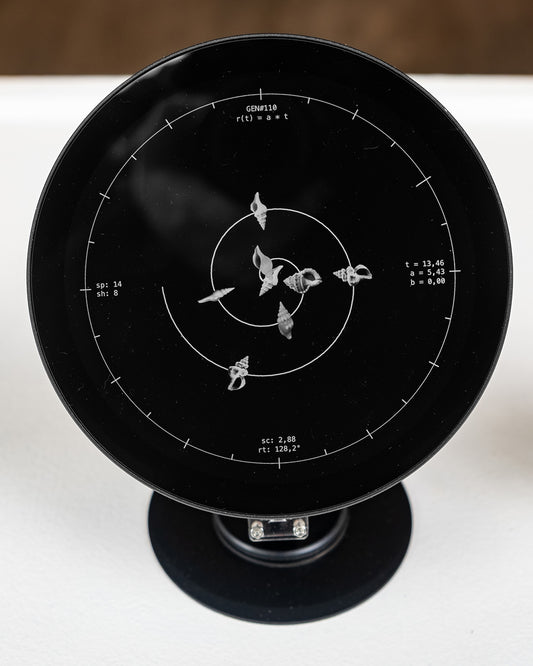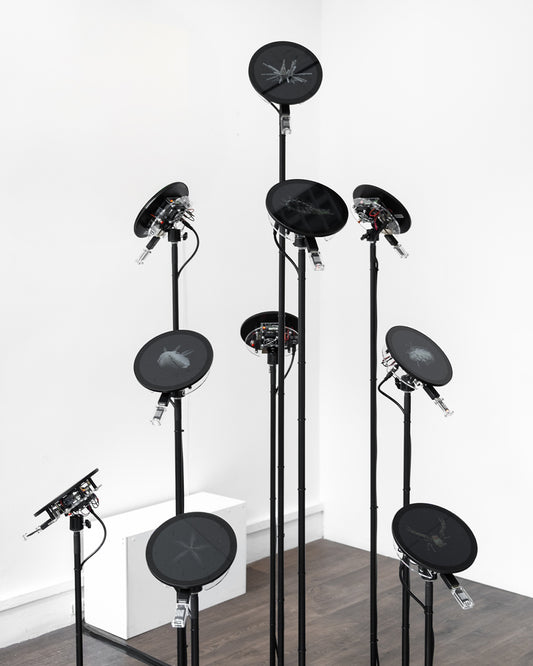avec Kazumasa Teshigawara aka Qubibi, Bas Uterwijk aka Ganbrood, Gunther Kleinert, Daniela Kröhnert, Arnaud Pfeffer, Florian Zumbrunn
COLOR[FRAME] is the 3rd exhibition realized by the Galerie Data around generative art. Dedicated to the theme of color, it is hosted by Plateforme Paris, from May 20th to June 5th 2022. from 20th May to 5th June 2022.
In 2020, GENERATIVE, introduced programmed generative art, and in particular the search for materiality through printing with a robotic arm. The second edition BIOMORPH, focused on the generation of forms tending to resemble living world.
The new edition presents a specific creation around color in the current generative practices, through digital tools and their robotic applications.
The artists presented are from various disciplines ; photographers, developers, architects, designers ... they embody a decompartmentalization between practices, and the advent of new modes of creation in connection with technology.
They engage in a dialogue with machines that pushes the limits of artistic creation, experimenting with its sensitive and unexpected expressions, linked to the random parameters of code.
The artworks presented are achieved with multiple processes: creative coding, the use of GANs (Generative Adversarial Networks), printing with a robotic arm (plotter), and the mechanical detour of tools.
The artists use algorithms to create many possible responses to their instructions, and visualize the graphic outputs.
A particularity of the generative process is that a project is built as a matrix, from which the artist can reproduce or recreate multiple variations, modifying the parameters which have an impact on the visual result.
They sometimes combine the use of a digital approach with a more mechanical one. Through the use of robotic plotters, they explore the passage between the digital and physical matter. The code is embodied in a physical work of art, which offers different aspects to the fabrication, depending on the choice of tools and materials.
The exhibition deals with different aspects of color related to the creation of generative artworks. Whether it is programmed by the artist, via an algorithm that generates and determines the rules of color distribution in the composition, from the compilation of a large source of images by artificial intelligence tools, or linked to robotic applications and physical materialization.
Although working with digital palettes, they handle the fundamental principles of color constitution, and determine with the code the rules of color distribution in space. As in painting, they exploit the notions of scale, complementarity, superimposition and transparency.
The artists explore generative possibilities in a concept between color and form. Color is considered a constituent element of the artworks and fully integrated into its realization.
Thus in the project “Mimizu”, a generative algorithm that the Japanese artist Kazumasa Teshigawara has been developing over the long term, the parameter of the color itself that determines the generation of the form.
From a “digital point“ the code creates a weaving of successive layers, generated by the interaction of colors between them. The artist has programmed the rules that govern the algorithm, which acquires its own autonomy by combining the graphic possibilities.
“My approach is similar to the act of putting a random drop of oil color on the surface of water. I don’t know what the result will be.“ Kazumasa Teshigawara
Bas Uterwijk, a Dutch artist who defines himself as a post-photographer, uses GANs (Generative Adversarial Networks) to explore the limits through painting and photography. He creates compositions between figuration and abstraction from a large number of images that are compiled by artificial intelligence. The rules for the distribution of colors in space are thus determined.
The algorithm gives its own interpretation of the source colors, or even invent them if this one is monochrome.
Sometimes the artist little understands the AI’s color perception, preferring instead not to over-rationalize the effects and the characteristics of artificial intelligence with the aim of preserving creative potential.
“The magic is very important in my process and I sometimes feel too much knowledge on how it works could kill my inspiration.” Bas Uterwijk
Daniela Kröhnert is a Viennese artist and teacher specializing in digital fabrication.
The artist has an almost “impressionist“ approach to color. By simplifying in
a frame, the nuances contained in an image are retranscribed into a colorful atmosphere in a retinal impression.
She thus questions our relationship with colors. What would be our difference of perception between a sky and a blue flat? Will they provoke the same impressions, evoke the same memories...
Her series Colo(u)r fields is an algorithmic color study focusing on the tension between order and randomness. Each drawing is a grid filled semi-randomly, according to parameters such as CMYK color, gradient direction and color mixing.
German artist and designer, Gunther Kleinert, works around the visualization of music. He uses the capture of sound and visual sources as an original score of the creation of forms. From these data, he defines a graphic and colorful language which superimposes information between them. During the drawing, with the robotic arm, the successive layers intermingle, the colors mix in transparency and are embodied in the matter.
In his series ‘I can see music’ he assigns shapes and colors to information in a poem to create a visual vocabulary. The different layers such as frequency curves, sound levels and dynamics are extracted, then mapped and drawn on paper with a robotic arm.
The series ‘The sound of’ is constructed from the data of a phenomenon while being the conceptual representation of it. The colors and density of the lines are defined by the physical sound parameters of a location. This information is superimposed on a photograph of the place taken at the same time.
Arnaud Pfeffer, industrial designer, has a digital and artisanal approach. Inspired by the maker movement, his research is based on detournment, for example by modifying the mechanics of robotic elements to obtain different graphic effects.
“Through my experiments, I explore the link between the unexpectedness of matter and the precision of code.“ Arnaud Pfeffer
His approach to color pass through the tools he uses, brushes, markers and pens, to obtain different graphics layers and superposition of colors.
He chooses them according to their chemical composition, which influences certain aspects of the material, and adapts his inks in order to control certain parameters such as saturation, viscosity or roughness.
Florian Zumbrunn, a creative developer who divides is time between Paris and Japan, programs algorithms that evolves over the long term. He uses Javascript/ Webgl programming, that allows the visualization of complex elements with a lot of information.
For his series “Digital embroideries“ he created a specific code that works in layers with a principle close to weaving. First, a black and white pattern is made for each color layer, which are superimposed to constitute the image. Each layer has the information of the previous layer, which will determine the position of the color in space by the principle of addition / subtraction of colors between them.
Thus there is an interdependence in the creation of color and form, which are often conceptualized to react together. The artists experiment with the results offered by the part controlled by code and tools, versus the random notion offered by the machine.

![COLOR[FRAME]](http://www.galeriedata.com/cdn/shop/articles/galeriedata_fd_colorframe.jpg?v=1676651984&width=1100)

